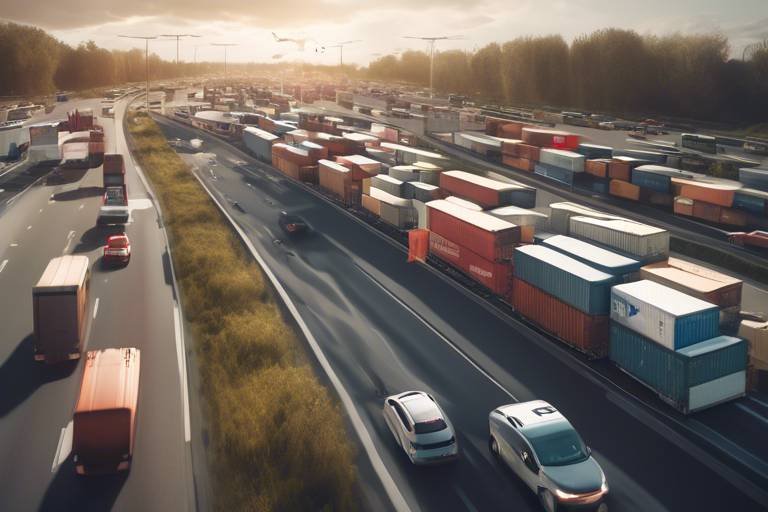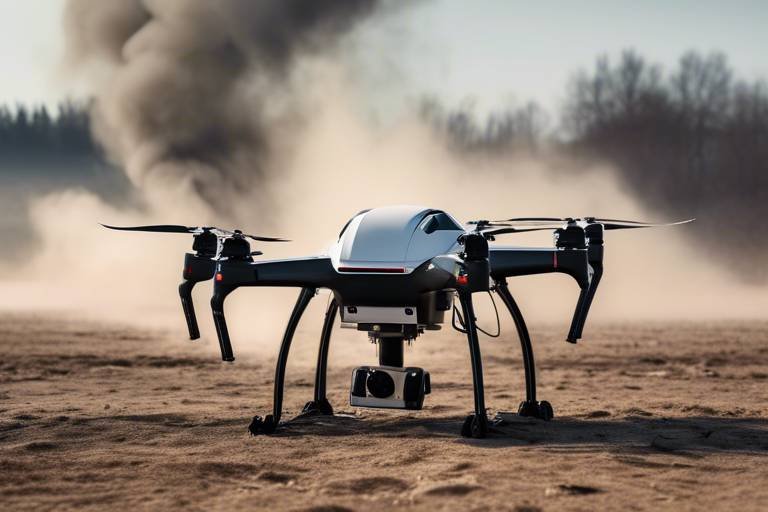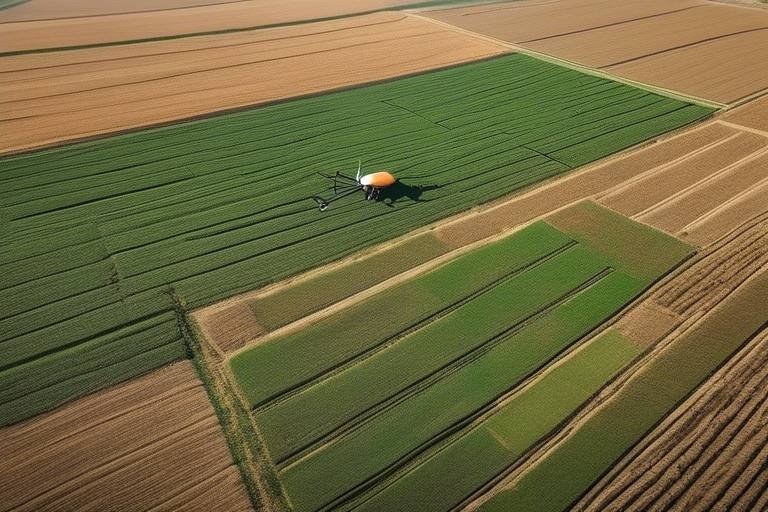Exploring the Use of Autonomous Vehicles in Freight Transportation
The freight transportation industry is on the brink of a revolution, and at the heart of this transformation are autonomous vehicles. These self-driving machines promise to reshape how goods are transported, making logistics not only more efficient but also safer. Imagine a world where trucks drive themselves, navigating complex roadways without human intervention, delivering packages with pinpoint accuracy. Sounds futuristic, right? Yet, this is the reality we are rapidly approaching. The integration of technology into freight transportation is not just a trend; it’s a necessity driven by the demands of a growing global economy.
Technological advancements have paved the way for the emergence of autonomous vehicles in freight transportation. Innovations such as artificial intelligence, machine learning, and advanced sensor technologies have significantly enhanced our ability to create vehicles that can operate independently. These vehicles are equipped with sophisticated systems that allow them to perceive their environment, make decisions, and navigate through various conditions. The implications for the freight sector are profound. For instance, autonomous trucks can operate 24/7 without the need for breaks, drastically increasing productivity. Moreover, as these technologies continue to evolve, we can expect to see even more capabilities, such as improved route optimization and real-time traffic management.
The advantages of using autonomous vehicles in freight transportation are numerous and compelling. Firstly, they offer significant efficiency gains. With the ability to operate continuously and optimize routes in real-time, these vehicles can drastically reduce delivery times. Additionally, the potential for cost reduction cannot be ignored. By minimizing the need for human drivers and optimizing fuel consumption, freight companies can significantly cut operational expenses. But that’s not all; safety is another critical area where autonomous vehicles shine. With advanced safety features, these vehicles can potentially reduce the number of accidents on the road, making transportation safer for everyone.
When discussing the financial implications of autonomous vehicles, one cannot overlook the potential for cost efficiency. By automating freight transport, companies can lower labor costs significantly. Imagine a scenario where a fleet of trucks operates without the need for drivers; this could lead to substantial savings in wages and benefits. Furthermore, autonomous vehicles are designed to optimize fuel consumption, which can lead to lower fuel expenses over time. The combination of these factors positions autonomous vehicles as a game-changer for freight companies looking to enhance their bottom line.
Fuel efficiency is a pressing concern in the freight industry, and autonomous driving technology holds the key to addressing this challenge. By utilizing algorithms that analyze traffic patterns and optimize driving speeds, autonomous vehicles can enhance fuel efficiency. This not only results in cost savings for companies but also contributes to a reduction in carbon emissions. In a world increasingly focused on sustainability, this aspect of autonomous vehicles is particularly appealing.
Another financial benefit of autonomous vehicles lies in their potential to lower maintenance costs. With the advent of predictive maintenance technologies, these vehicles can monitor their own health in real-time, alerting operators to potential issues before they become serious problems. This proactive approach minimizes downtime and reduces the costs associated with unexpected repairs. As a result, companies can maintain their fleets more effectively and ensure that their operations run smoothly.
Safety is paramount in freight transportation, and autonomous vehicles come equipped with advanced safety features designed to minimize accidents. Technologies such as collision avoidance systems and real-time monitoring are integral to these vehicles. They can detect obstacles, react to sudden changes in traffic conditions, and communicate with other vehicles on the road. This level of awareness and responsiveness significantly reduces the likelihood of accidents, making the roads safer for all users.
Despite the numerous benefits, the journey towards widespread adoption of autonomous vehicles in freight transportation is not without its challenges. Regulatory hurdles, public acceptance, and technological limitations pose significant obstacles that must be addressed. The regulatory landscape is particularly complex, with various laws and guidelines that companies must navigate to implement these technologies effectively.
The legal framework surrounding autonomous vehicles is still evolving. Companies must contend with a patchwork of regulations that vary by state and country. This complexity can create uncertainty and delay the deployment of autonomous vehicles in freight transportation. Additionally, there are concerns regarding liability in the event of accidents involving autonomous vehicles, which complicates the legal landscape further.
Current technological barriers also hinder the full deployment of autonomous vehicles. Limitations in sensor technology and data processing capabilities can affect the vehicle's ability to accurately perceive and navigate its environment. As technology continues to advance, these challenges are likely to diminish, but for now, they remain a significant hurdle for the industry.
- What are autonomous vehicles? Autonomous vehicles are self-driving vehicles that can operate without human intervention, using advanced sensors and AI technology.
- How do autonomous vehicles improve freight transportation? They enhance efficiency, reduce costs, and improve safety by minimizing human error and optimizing routes.
- What challenges do autonomous vehicles face? Regulatory hurdles, public acceptance, and technological limitations are some of the key challenges that need to be addressed.
The Rise of Autonomous Vehicles
The journey towards autonomous vehicles has been nothing short of revolutionary, reshaping the landscape of various industries, particularly freight transportation. Technological advancements have paved the way for these self-driving marvels, transforming the way goods are transported across the globe. From the early days of basic automation to today's sophisticated systems equipped with artificial intelligence, the evolution of autonomous vehicles is a testament to human ingenuity.
One of the most significant breakthroughs in this field has been the development of machine learning algorithms that allow vehicles to learn from their environment. These algorithms enable the vehicles to make real-time decisions, adapting to changing road conditions and traffic patterns. For instance, a self-driving truck can analyze data from its sensors to determine the safest route, avoiding congested areas or hazardous weather conditions. This level of adaptability was once the stuff of science fiction, but it is now becoming a reality.
Moreover, the integration of advanced sensors and LiDAR technology has been pivotal. These tools provide a 360-degree view of the vehicle's surroundings, allowing it to detect obstacles, pedestrians, and other vehicles with remarkable precision. In fact, the data collected from these sensors can be processed in milliseconds, enabling the vehicle to react faster than a human driver. This technological prowess not only enhances safety but also boosts efficiency in freight logistics.
As we delve deeper into the implications of autonomous vehicles, it’s essential to recognize the impact of connectivity. Vehicles are now equipped with the ability to communicate with each other and with infrastructure, creating a network that enhances overall traffic flow. Imagine a scenario where trucks can coordinate their routes, reducing congestion and minimizing delivery times. This interconnectedness is a game-changer, promising to streamline operations and improve service delivery.
However, this rise does not come without its challenges. The intersection of technology and regulation is a complex one. As autonomous vehicles become more prevalent, regulatory frameworks will need to evolve to accommodate these innovations. Policymakers must grapple with questions of liability, safety standards, and public acceptance. The road to widespread adoption is fraught with hurdles, but the potential benefits make it a journey worth undertaking.
In summary, the rise of autonomous vehicles is a multifaceted phenomenon driven by technological advancements, enhanced safety features, and increased connectivity. As we stand on the brink of this new era in freight transportation, it is clear that the future holds immense promise. The question remains: will society embrace this change, or will it take time for public sentiment to catch up with technological progress?
- What are autonomous vehicles? Autonomous vehicles are self-driving vehicles that use a combination of sensors, cameras, and artificial intelligence to navigate without human intervention.
- How do autonomous vehicles improve safety? They reduce human error, which is a leading cause of accidents, by utilizing advanced safety features like collision avoidance systems.
- What challenges do autonomous vehicles face? Key challenges include regulatory hurdles, public acceptance, and technological limitations that need to be addressed for widespread deployment.
Benefits of Autonomous Freight Transportation
The introduction of autonomous vehicles in the freight transportation sector is not just a trend; it represents a significant shift in how goods are moved across the globe. Imagine a world where trucks can drive themselves, navigating through traffic and delivering packages without human intervention. This isn't science fiction—it's the future, and it’s packed with a myriad of benefits that promise to revolutionize logistics. From enhanced efficiency to substantial cost savings, the advantages of autonomous freight transportation are numerous and compelling.
One of the most striking benefits of autonomous freight transportation is its efficiency. Autonomous vehicles are designed to optimize routes and reduce travel time. Using advanced algorithms, these vehicles can analyze traffic patterns, weather conditions, and road conditions in real-time, allowing them to choose the most efficient paths. This capability not only speeds up delivery times but also helps in reducing fuel consumption, which leads us to another critical benefit: cost reduction.
When we talk about cost efficiency, we’re diving into a world of savings that can change the game for freight companies. With autonomous vehicles, companies can significantly lower their operational costs. The reduction in labor costs is a major factor; fewer drivers mean less expenditure on wages, benefits, and training. Additionally, autonomous vehicles can operate longer hours without the need for breaks, leading to increased productivity. To illustrate, consider the following table that outlines potential savings:
| Cost Factor | Traditional Freight | Autonomous Freight |
|---|---|---|
| Labor Costs | $100,000/year | $20,000/year |
| Fuel Efficiency | 8 MPG | 12 MPG |
| Maintenance Costs | $15,000/year | $10,000/year |
This table clearly shows that the shift towards autonomous freight transportation can lead to substantial savings across various cost factors. For example, with optimized driving patterns, autonomous vehicles can achieve better fuel efficiency, which translates to lower emissions and significant cost savings. Fuel efficiency improvements are one of the hallmarks of this technology. By utilizing sophisticated algorithms, these vehicles can adjust their driving behavior—accelerating and braking smoothly, maintaining optimal speeds, and avoiding unnecessary idling.
Moreover, the potential for maintenance cost reductions cannot be overlooked. Autonomous vehicles are equipped with predictive maintenance technologies that monitor their own performance and health. This means that instead of waiting for a breakdown to occur, the vehicle can alert operators to potential issues before they become significant problems. This proactive approach minimizes downtime and keeps freight moving efficiently.
In addition to cost savings and efficiency, the enhanced safety features of autonomous vehicles are a game-changer. These vehicles are equipped with advanced collision avoidance systems and real-time monitoring that can detect potential hazards on the road. With features like automatic braking, lane-keeping assistance, and 360-degree cameras, the likelihood of accidents can be drastically reduced. Imagine a truck that can see and react faster than a human driver—this capability not only protects the cargo but also enhances the safety of other road users.
In summary, the benefits of autonomous freight transportation are vast and varied. From operational cost savings and fuel efficiency improvements to enhanced safety features, the shift towards autonomous vehicles offers an exciting glimpse into the future of logistics. As we continue to explore and embrace this technology, the potential for a more efficient, cost-effective, and safer freight transportation system seems not only possible but inevitable.
- What are autonomous vehicles? Autonomous vehicles are self-driving vehicles that use a combination of sensors, cameras, and artificial intelligence to navigate and operate without human intervention.
- How do autonomous vehicles improve safety in freight transportation? They are equipped with advanced safety features such as collision avoidance systems and real-time monitoring, which significantly reduce the risk of accidents.
- What cost savings can companies expect from using autonomous freight vehicles? Companies can save on labor costs, fuel consumption, and maintenance expenses, leading to overall lower operational costs.
- Are there any challenges to adopting autonomous freight vehicles? Yes, challenges include regulatory hurdles, public acceptance, and current technological limitations that need to be addressed for widespread adoption.
Cost Efficiency
When we talk about in the realm of autonomous freight transportation, it’s like opening a treasure chest filled with opportunities. Imagine a world where freight companies can operate with significantly lower expenses while simultaneously boosting their productivity. This isn’t just a pipe dream; it’s becoming a reality thanks to the rise of autonomous vehicles. One of the most compelling aspects of these vehicles is their potential to reduce labor costs. Traditional trucking relies heavily on human drivers, which means salaries, benefits, and other associated costs. By integrating autonomous technology, companies can minimize or even eliminate these expenses, leading to a more streamlined operation.
Additionally, the optimization of fuel consumption plays a crucial role in enhancing cost efficiency. Autonomous vehicles utilize advanced algorithms and real-time data to determine the most efficient routes and driving patterns. This not only results in lower fuel costs but also contributes to a significant decrease in carbon emissions. Picture this: a fleet of trucks navigating the highways, adjusting their speed and route in real-time to avoid traffic jams and reduce fuel usage. The result is a win-win situation for both the environment and the bottom line.
To illustrate the potential savings, let’s take a look at a simple comparison table that highlights the differences in operational costs between traditional freight transportation and autonomous freight systems:
| Cost Factor | Traditional Freight | Autonomous Freight |
|---|---|---|
| Labor Costs | High | Low |
| Fuel Costs | Moderate | Lower |
| Maintenance Costs | Regular | Reduced |
| Insurance Costs | Higher | Potentially Lower |
As we delve deeper into the topic, we can’t ignore the role of predictive maintenance technologies that autonomous vehicles employ. These systems monitor vehicle health in real-time, alerting companies about potential issues before they escalate into costly repairs. This proactive approach not only minimizes downtime but also ensures that trucks are operating at peak performance, further enhancing productivity and cost savings. Just think of it as having a personal mechanic that’s always on call, ready to spot issues before they become major headaches.
In summary, the of autonomous freight transportation is a game changer for the logistics industry. By reducing labor and fuel costs, optimizing routes, and implementing predictive maintenance, companies can significantly enhance their bottom line. It’s like having a well-oiled machine that runs smoothly, maximizing profits while minimizing waste. The future of freight is not just about getting goods from point A to point B; it’s about doing so in the most cost-effective way possible, and autonomous vehicles are leading the charge.
Fuel Efficiency Improvements
When it comes to the logistics industry, fuel efficiency isn't just a buzzword; it's a lifeline. The introduction of autonomous vehicles (AVs) into freight transportation is set to revolutionize how we think about fuel consumption. Imagine a world where trucks can communicate with one another, sharing real-time data to optimize routes and driving patterns. This isn't science fiction; it's the future of freight logistics. With advanced algorithms and machine learning, autonomous vehicles can analyze traffic patterns, weather conditions, and road types to choose the most fuel-efficient routes.
One of the most significant advantages of AVs is their ability to maintain a constant speed, which is crucial for fuel efficiency. Traditional freight vehicles often deal with erratic driving behaviors—accelerating and braking frequently, which wastes fuel and increases emissions. In contrast, autonomous vehicles are designed to drive smoothly and consistently, reducing fuel consumption significantly. According to studies, it’s estimated that AVs can improve fuel efficiency by up to 20% compared to human drivers. This not only translates to lower costs but also contributes to a greener planet.
Moreover, autonomous vehicles utilize cutting-edge technologies such as adaptive cruise control and predictive routing. These features allow the vehicle to adjust its speed and route based on real-time data, ensuring that it operates in the most fuel-efficient manner possible. For instance, if an AV detects heavy traffic ahead, it can reroute to avoid congestion, which not only saves fuel but also reduces delivery times. This adaptability makes AVs a game-changer in the freight industry.
In addition to driving patterns, the design of autonomous vehicles plays a critical role in enhancing fuel efficiency. Many AVs are built with lightweight materials and aerodynamic shapes, further reducing drag and improving fuel consumption. The integration of electric and hybrid technologies into autonomous freight vehicles also presents a promising avenue for reducing reliance on fossil fuels. With the world increasingly shifting towards sustainable energy sources, the combination of AV technology and alternative fuels could pave the way for a more sustainable future in freight transportation.
To summarize, the fuel efficiency improvements brought about by autonomous vehicles are not just beneficial for cost savings; they are essential for creating a more sustainable logistics industry. By optimizing driving patterns, utilizing advanced technologies, and embracing innovative designs, AVs can significantly lower fuel consumption and emissions, making them a vital component of the future of freight transportation.
Maintenance Cost Reductions
When we think about the future of freight transportation, one of the most exciting aspects is the potential for that autonomous vehicles bring to the table. Imagine a world where logistics companies can save significant amounts of money simply by leveraging advanced technology! With autonomous vehicles, the dream of lower maintenance costs is becoming a reality, thanks to innovations in predictive maintenance and real-time monitoring systems.
First off, let’s dive into how predictive maintenance works. Unlike traditional methods that often rely on scheduled maintenance or reactive repairs, predictive maintenance uses data analytics to predict when a vehicle is likely to experience a failure. This means that instead of waiting for something to go wrong, companies can address issues before they escalate, ensuring that their fleet remains operational and efficient. By analyzing factors such as vehicle performance, environmental conditions, and usage patterns, autonomous vehicles can alert operators to potential problems, allowing for timely interventions.
For instance, consider a scenario where an autonomous truck detects that its brakes are wearing down faster than expected. Instead of waiting for a brake failure to occur, the vehicle can send a notification to the fleet manager, prompting them to schedule a maintenance check. This proactive approach not only prevents costly breakdowns but also minimizes downtime, which is crucial in the fast-paced world of logistics.
Moreover, the integration of IoT (Internet of Things) devices into autonomous vehicles enhances maintenance capabilities. These devices continuously collect data on various components, such as engine performance and tire pressure, allowing for a comprehensive overview of the vehicle’s health. With this wealth of information, logistics companies can make informed decisions about when to service a vehicle, thus optimizing their maintenance schedules and reducing unnecessary costs.
To illustrate the potential savings, let’s take a look at a simple comparison of maintenance costs between traditional vehicles and autonomous vehicles:
| Vehicle Type | Annual Maintenance Cost | Downtime (Days) |
|---|---|---|
| Traditional Vehicles | $10,000 | 15 |
| Autonomous Vehicles | $5,000 | 5 |
As shown in the table, the annual maintenance cost for autonomous vehicles can be significantly lower, potentially halving the expenses that traditional vehicles incur. Additionally, with reduced downtime, companies can focus on maximizing their operational efficiency, leading to increased profitability.
In summary, the associated with autonomous vehicles represent a game-changer for the freight transportation industry. By embracing predictive maintenance and leveraging real-time data analytics, companies can not only save money but also enhance their overall operational efficiency. It's clear that as technology continues to evolve, the logistics landscape will transform in ways we can only begin to imagine.
- How does predictive maintenance work in autonomous vehicles?
Predictive maintenance uses data analytics to forecast potential vehicle failures, allowing for timely repairs before issues escalate. - What are the main benefits of lower maintenance costs?
Lower maintenance costs lead to reduced operational expenses, minimized downtime, and increased efficiency in logistics operations. - Can autonomous vehicles completely eliminate maintenance costs?
While autonomous vehicles can significantly reduce maintenance costs, they cannot completely eliminate them as regular servicing will still be necessary.
Enhanced Safety Features
One of the most compelling arguments for the adoption of autonomous vehicles in freight transportation is the significant enhancement in safety features. Imagine a world where trucks are equipped with advanced technologies that not only help in navigating the roads but also actively prevent accidents. These vehicles are designed with state-of-the-art collision avoidance systems, which utilize a combination of sensors, cameras, and artificial intelligence to detect potential hazards on the road. This means that they can react faster than human drivers, reducing the likelihood of accidents caused by human error, which is a leading factor in road incidents.
Furthermore, autonomous vehicles are equipped with real-time monitoring systems that continuously assess the vehicle's surroundings. These systems can analyze data from multiple sources, including other vehicles and traffic signals, to make informed decisions in a fraction of a second. For instance, if an obstacle suddenly appears in the vehicle's path, the system can instantly calculate the best course of action, whether that be to brake, swerve, or take another precautionary measure. This level of responsiveness is something that human drivers, no matter how skilled, cannot consistently achieve.
Additionally, many autonomous freight vehicles come with features such as adaptive cruise control and lane-keeping assistance. These technologies work together to maintain safe distances between vehicles and ensure they stay within their designated lanes, further minimizing the risk of collisions. According to studies, these features can significantly reduce rear-end collisions and lane change accidents, which are common in traditional freight transport.
To illustrate the effectiveness of these safety features, consider the following table that compares accident rates between traditional freight trucks and autonomous vehicles equipped with advanced safety technologies:
| Vehicle Type | Accident Rate (per million miles) |
|---|---|
| Traditional Freight Trucks | 4.5 |
| Autonomous Freight Vehicles | 1.2 |
As shown in the table, autonomous freight vehicles have a significantly lower accident rate compared to their traditional counterparts. This reduction in accidents not only enhances the safety of the drivers but also contributes to the overall safety of other road users, including pedestrians and cyclists.
In conclusion, the enhanced safety features of autonomous vehicles are not just a technological advancement; they represent a paradigm shift in how we approach freight transportation. With fewer accidents and improved safety measures, these vehicles promise a safer future on the roads. As the industry continues to evolve, it is crucial for stakeholders to recognize and invest in these technologies to fully realize their potential.
- What are the main safety features of autonomous freight vehicles?
The main safety features include collision avoidance systems, real-time monitoring, adaptive cruise control, and lane-keeping assistance.
- How do autonomous vehicles reduce accidents?
They reduce accidents by reacting faster than human drivers and continuously assessing their surroundings to make informed decisions.
- Are autonomous freight vehicles safer than traditional trucks?
Yes, studies show that autonomous freight vehicles have a significantly lower accident rate compared to traditional trucks.
Challenges Facing Autonomous Freight Vehicles
The journey towards integrating autonomous vehicles in the freight transportation sector is not without its hurdles. While the technology promises to revolutionize logistics, several significant challenges must be addressed before it can be widely adopted. One of the primary obstacles is the complex regulatory landscape that governs the operation of these vehicles. Different regions have varying laws, and navigating these regulations can be a daunting task for companies looking to implement autonomous technology. For instance, some states may have stringent testing requirements, while others might not yet have established clear guidelines for the operation of self-driving trucks.
Moreover, public acceptance plays a crucial role in the successful deployment of autonomous freight vehicles. Many people are still skeptical about the safety and reliability of self-driving technology. Concerns about job displacement for truck drivers and the potential for accidents involving autonomous vehicles contribute to this skepticism. To counter these fears, companies must engage in effective communication strategies that educate the public on the safety features and benefits of autonomous vehicles.
Technological limitations also pose a significant challenge. While advancements in sensors and artificial intelligence have made great strides, there are still gaps that need to be filled. For example, the ability of autonomous vehicles to navigate complex environments, such as urban areas with unpredictable traffic patterns, remains a significant hurdle. Additionally, the data processing capabilities required for real-time decision-making in diverse driving conditions are still evolving. Companies must invest in research and development to overcome these technological barriers and ensure that their vehicles can operate safely and efficiently in all scenarios.
To summarize, the challenges facing autonomous freight vehicles can be categorized into three main areas:
- Regulatory and Legal Issues: The need for clear and consistent regulations across different regions.
- Public Acceptance: Overcoming skepticism and educating the public about the benefits and safety of autonomous technology.
- Technological Limitations: Addressing gaps in sensor technology and data processing capabilities.
As the industry moves forward, addressing these challenges will be essential for paving the way for the future of autonomous freight transportation. Collaboration between technology developers, regulatory bodies, and the public will be crucial in shaping the path ahead. Only by working together can we harness the full potential of autonomous vehicles to create a safer, more efficient logistics ecosystem.
1. What are the main challenges facing autonomous freight vehicles?
The main challenges include regulatory and legal issues, public acceptance, and technological limitations that hinder the widespread adoption of autonomous vehicles in freight transportation.
2. How can companies address public skepticism about autonomous vehicles?
Companies can address public skepticism by engaging in effective communication strategies that educate the public on the safety features and benefits of autonomous vehicles, as well as addressing concerns regarding job displacement.
3. What role do regulations play in the deployment of autonomous freight vehicles?
Regulations play a critical role in ensuring the safe operation of autonomous vehicles. Clear and consistent regulations across regions are necessary to facilitate the testing and implementation of this technology.
4. What technological advancements are needed for autonomous freight vehicles?
Advancements in sensor technology, artificial intelligence, and data processing capabilities are essential for enabling autonomous vehicles to navigate complex driving environments safely and efficiently.
Regulatory and Legal Issues
The journey towards integrating autonomous vehicles into the freight transportation sector is not just about technological advancements; it also involves navigating a complex web of . Each state and country has its own set of laws governing the use of autonomous vehicles, creating a patchwork of regulations that can be challenging for companies to understand and comply with. For instance, what might be permissible in California could be strictly prohibited in Texas. This inconsistency can lead to confusion and hesitation among freight companies considering the adoption of autonomous technology.
Moreover, the regulatory landscape is continuously evolving. As technology advances, lawmakers are tasked with updating existing laws or creating new ones to keep pace with innovations. This can lead to a lag between technological capabilities and legal frameworks, which may stifle the growth of autonomous freight solutions. Companies must stay informed about these changes to ensure compliance and avoid potential legal pitfalls.
Another significant aspect of the regulatory challenges is the liability issue. In the event of an accident involving an autonomous vehicle, determining who is at fault can be complicated. Is it the manufacturer, the software developer, or the freight company? This ambiguity can create legal liabilities that deter companies from fully embracing autonomous technology. The lack of clear guidelines on liability not only poses a risk for companies but also raises concerns for insurance providers, who may be hesitant to cover autonomous vehicles without established protocols.
To address these challenges, some regions are beginning to implement pilot programs and regulatory sandboxes that allow companies to test autonomous vehicles under controlled conditions. These initiatives aim to gather data, refine regulations, and foster public acceptance. However, the success of such programs largely depends on collaboration between government agencies, industry stakeholders, and the public. Without a unified approach, the potential of autonomous freight vehicles may remain untapped.
In summary, while the promise of autonomous vehicles in freight transportation is immense, the road to widespread adoption is fraught with regulatory and legal challenges. Companies must navigate this intricate landscape carefully, ensuring compliance while advocating for clearer regulations that support innovation. As the industry evolves, ongoing dialogue between lawmakers and industry leaders will be essential to pave the way for a future where autonomous freight vehicles can operate safely and effectively.
- What are the primary regulatory challenges for autonomous freight vehicles?
Autonomous freight vehicles face challenges such as inconsistent state laws, liability issues, and evolving regulations that can hinder their adoption. - How are companies addressing liability concerns?
Companies are advocating for clearer regulations and exploring insurance solutions tailored to autonomous vehicles to mitigate liability risks. - What role do pilot programs play in regulatory development?
Pilot programs allow companies to test autonomous vehicles in controlled environments, helping to gather data and refine regulations.
Technological Limitations
As we stand on the brink of a revolution in freight transportation, it's essential to recognize that the journey toward fully autonomous vehicles is not without its hurdles. The of these vehicles present significant challenges that must be addressed for them to be widely adopted in the logistics sector. While advancements in artificial intelligence, machine learning, and sensor technologies have propelled the development of autonomous vehicles, several key issues remain that could hinder their effectiveness and safety.
One of the primary challenges is the limitations of sensor technology. Autonomous vehicles rely heavily on various sensors, including LiDAR, cameras, and radar, to perceive their environment. However, these sensors can struggle in adverse weather conditions like heavy rain, fog, or snow. For instance, LiDAR systems may have difficulty detecting objects in low visibility, while cameras may struggle to interpret road signs or lane markings obscured by weather elements. This raises a critical question: how can we ensure that these vehicles operate safely in all conditions?
Moreover, the data processing capabilities of autonomous vehicles are another limiting factor. These vehicles generate vast amounts of data from their sensors, which must be processed in real-time to make split-second decisions. Current systems can face challenges in processing this data efficiently, leading to potential delays in reaction times. Imagine driving on a busy highway where every second counts; if an autonomous vehicle can't process its surroundings quickly enough, it could lead to disastrous outcomes.
Additionally, the integration of various technologies poses a challenge. Autonomous vehicles must seamlessly interact with existing infrastructure, including traffic signals, road signs, and even other vehicles. However, not all roads are equipped with the necessary technology to support this integration. For example, many urban areas still rely on outdated traffic management systems that do not communicate with autonomous vehicles. This lack of compatibility can create confusion and inefficiencies, further complicating the deployment of these vehicles.
Furthermore, the cybersecurity risks associated with autonomous vehicles cannot be overlooked. As these vehicles become more connected, they also become more vulnerable to hacking and cyber-attacks. A malicious actor could potentially take control of a fleet of autonomous trucks, posing a significant threat to public safety and security. Hence, ensuring robust cybersecurity measures is crucial for building trust in this technology.
In conclusion, while the promise of autonomous vehicles in freight transportation is exciting, we must address these technological limitations to realize their full potential. The road ahead is filled with challenges, but by investing in research and development, fostering collaboration between tech companies and regulatory bodies, and prioritizing safety and security, we can pave the way for a future where autonomous vehicles enhance the efficiency and safety of logistics operations.
- What are the main technological limitations of autonomous vehicles? The main limitations include sensor technology challenges, data processing capabilities, integration with existing infrastructure, and cybersecurity risks.
- How do weather conditions affect autonomous vehicles? Adverse weather can impair the functionality of sensors, affecting the vehicle's ability to perceive its environment accurately.
- What is being done to improve the safety of autonomous vehicles? Ongoing research and development focus on enhancing sensor technologies, improving data processing, and ensuring robust cybersecurity measures.
Frequently Asked Questions
- What are autonomous vehicles in freight transportation?
Autonomous vehicles in freight transportation are self-driving trucks and delivery vehicles that use advanced technology to navigate and transport goods without human intervention. They're designed to improve efficiency, reduce costs, and enhance safety in the logistics industry.
- How do autonomous vehicles improve efficiency in freight transport?
These vehicles optimize routes, reduce idle time, and maintain consistent speeds, which leads to faster delivery times. By minimizing human error and maximizing operational capabilities, they can significantly enhance the overall efficiency of the freight transport process.
- What are the cost benefits of using autonomous vehicles?
Autonomous vehicles can lower operational costs by reducing labor expenses, minimizing fuel consumption through optimized driving patterns, and decreasing maintenance costs with predictive maintenance technologies. This results in a more cost-effective logistics operation.
- Are autonomous vehicles safer than traditional freight vehicles?
Yes, autonomous vehicles are equipped with advanced safety features like collision avoidance systems and real-time monitoring. These technologies help reduce the likelihood of accidents on the road, making freight transportation safer for everyone involved.
- What challenges do autonomous freight vehicles face?
Despite their potential, autonomous freight vehicles encounter challenges such as regulatory hurdles, public acceptance issues, and technological limitations. These factors must be addressed for widespread adoption and successful implementation in the industry.
- How do regulations impact the use of autonomous vehicles?
The regulatory landscape for autonomous vehicles is complex and varies by region. Companies must navigate various legal challenges, including safety standards, liability issues, and operational guidelines, to effectively implement these technologies in freight transportation.
- What are the current technological limitations of autonomous vehicles?
Current technological limitations include sensor accuracy, data processing challenges, and the ability to operate in diverse weather conditions. These barriers need to be overcome to enable full deployment and reliability of autonomous vehicles in freight transport.



















